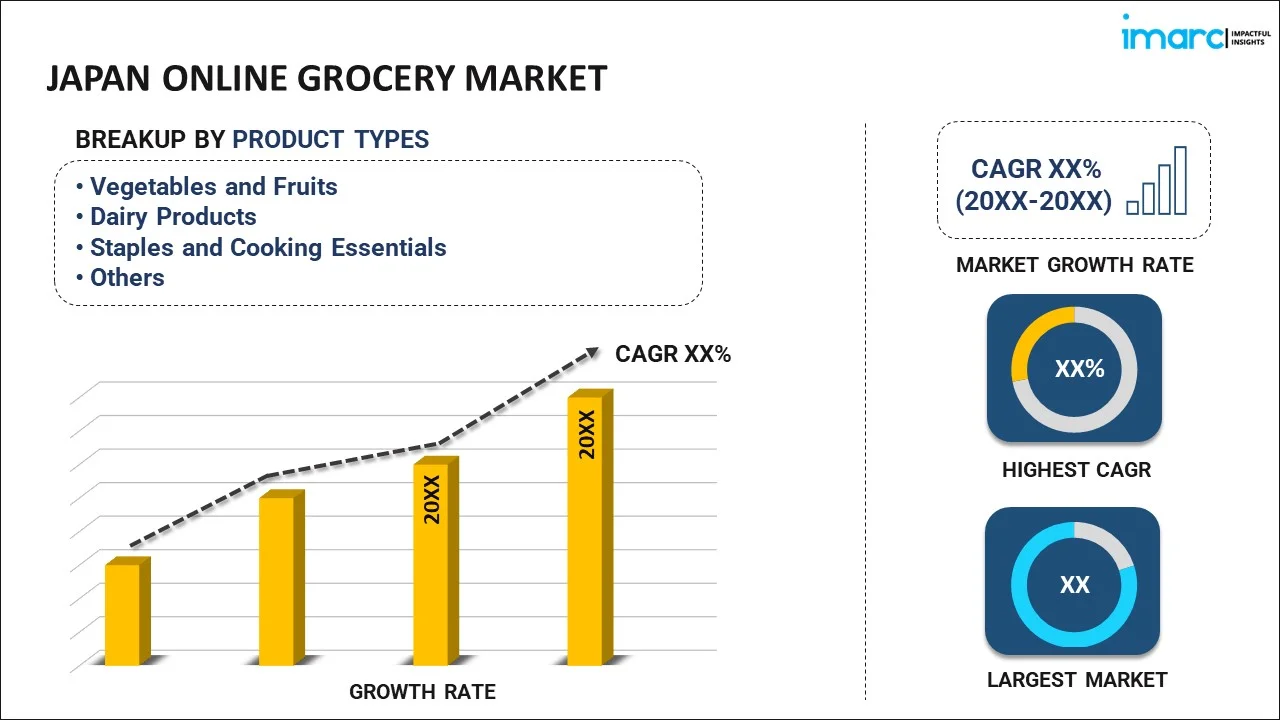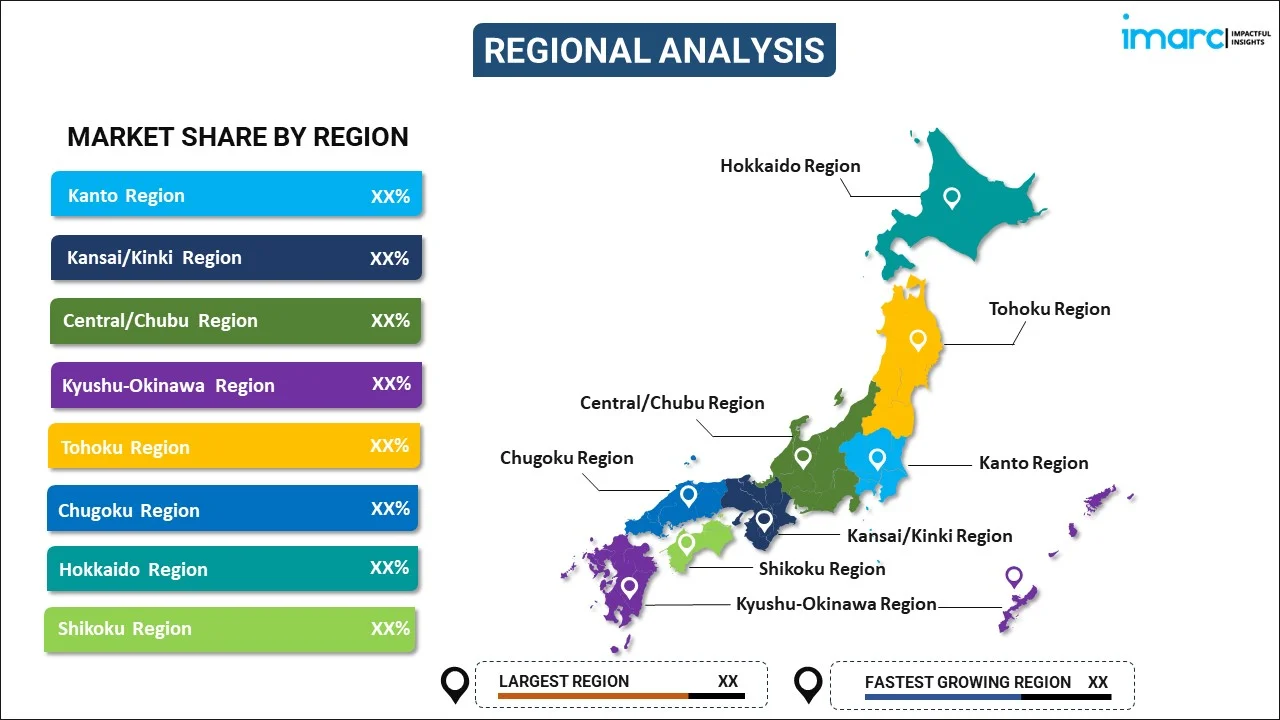
Japan Online Grocery Market Report by Product Type (Vegetables and Fruits, Dairy Products, Staples and Cooking Essentials, Snacks, Meat and Seafood, and Others), Business Model (Pure Marketplace, Hybrid Marketplace, and Others), Platform (Web-Based, App-Based), Purchase Type (One-Time, Subscription), and Region 2025-2033
Market Overview:
Japan online grocery market size reached USD 40.4 Billion in 2024. Looking forward, IMARC Group expects the market to reach USD 271.9 Billion by 2033, exhibiting a growth rate (CAGR) of 23.6% during 2025-2033. The increasing advancements in technology that have led to the development of user-friendly interfaces and mobile applications, making it easier for customers to navigate and shop on online grocery platforms, are driving the market.
|
Report Attribute
|
Key Statistics
|
|---|---|
|
Base Year
|
2024 |
|
Forecast Years
|
2025-2033 |
|
Historical Years
|
2019-2024
|
| Market Size in 2024 | USD 40.4 Billion |
| Market Forecast in 2033 | USD 271.9 Billion |
| Market Growth Rate (2025-2033) | 23.6% |
Online grocery shopping refers to the process of purchasing food and household items via the Internet. This modern convenience allows customers to browse a virtual catalog of products, select items, and complete transactions through various digital platforms. Consumers can choose from a wide array of products, including fresh produce, pantry staples, and other everyday essentials. Online grocery services often offer delivery or pickup options, providing added convenience and flexibility for busy individuals or those with limited mobility. Customers can compare prices, access digital coupons, and take advantage of personalized recommendations based on their shopping history. The popularity of online grocery shopping has grown significantly, as it offers a safe and convenient alternative to traditional in-store shopping. With the expansion of online grocery retailers and the integration of advanced technologies, the industry continues to evolve, offering enhanced user experiences and efficient delivery services.
Japan Online Grocery Market Trends:
The rapid growth of the online grocery market in Japan can be attributed to various factors. Firstly, the burgeoning digital infrastructure has facilitated the seamless integration of e-commerce platforms, enabling consumers to effortlessly browse and purchase products. Additionally, the widespread proliferation of smartphones and the internet has significantly augmented the accessibility of online grocery services, amplifying their reach to a diverse demographic. Furthermore, the convenience offered by doorstep deliveries and the provision of flexible delivery slots has attracted an increasing number of time-pressed consumers, thereby fueling the demand for online grocery shopping. Moreover, the heightened awareness regarding health and safety concerns has prompted a surge in the preference for contactless transactions, further propelling the adoption of online grocery services. Moreover, the implementation of sophisticated data analytics and personalized recommendation systems has enhanced the customer shopping experience, fostering customer loyalty and retention. Lastly, the introduction of innovative subscription models and attractive discounts has incentivized customers to opt for online grocery shopping, consolidating the sustained growth of this dynamic market sector in Japan.
Japan Online Grocery Market Segmentation:
IMARC Group provides an analysis of the key trends in each segment of the market, along with forecasts at the country level for 2025-2033. Our report has categorized the market based on product type, business model, platform, and purchase type.
Product Type Insights:

- Vegetables and Fruits
- Dairy Products
- Staples and Cooking Essentials
- Snacks
- Meat and Seafood
- Others
The report has provided a detailed breakup and analysis of the market based on the product type. This includes vegetables and fruits, dairy products, staples and cooking essentials, snacks, meat and seafood, and others.
Business Model Insights:
- Pure Marketplace
- Hybrid Marketplace
- Others
A detailed breakup and analysis of the market based on the business model have also been provided in the report. This includes pure marketplace, hybrid marketplace, and others.
Platform Insights:
- Web-Based
- App-Based
The report has provided a detailed breakup and analysis of the market based on the platform. This includes web-based and app-based.
Purchase Type Insights:
- One-Time
- Subscription
A detailed breakup and analysis of the market based on the purchase type have also been provided in the report. This includes one-time and subscription.
Regional Insights:

- Kanto Region
- Kansai/Kinki Region
- Central/ Chubu Region
- Kyushu-Okinawa Region
- Tohoku Region
- Chugoku Region
- Hokkaido Region
- Shikoku Region
The report has also provided a comprehensive analysis of all the major regional markets, which include Kanto Region, Kansai/Kinki Region, Central/ Chubu Region, Kyushu-Okinawa Region, Tohoku Region, Chugoku Region, Hokkaido Region, and Shikoku Region.
Competitive Landscape:
The market research report has also provided a comprehensive analysis of the competitive landscape. Competitive analysis such as market structure, key player positioning, top winning strategies, competitive dashboard, and company evaluation quadrant has been covered in the report. Also, detailed profiles of all major companies have been provided.
Japan Online Grocery Market Report Coverage:
| Report Features | Details |
|---|---|
| Base Year of the Analysis | 2024 |
| Historical Period | 2019-2024 |
| Forecast Period | 2025-2033 |
| Units | Billion USD |
| Scope of the Report | Exploration of Historical and Forecast Trends, Industry Catalysts and Challenges, Segment-Wise Historical and Predictive Market Assessment:
|
| Product Types Covered | Vegetables and Fruits, Dairy Products, Staples and Cooking Essentials, Snacks, Meat and Seafood, Others |
| Business Models Covered | Pure Marketplace, Hybrid Marketplace, Others |
| Platforms Covered | Web-Based, App-Based |
| Purchase Types Covered | One-Time, Subscription |
| Regions Covered | Kanto Region, Kansai/Kinki Region, Central/ Chubu Region, Kyushu-Okinawa Region, Tohoku Region, Chugoku Region, Hokkaido Region, Shikoku Region |
| Customization Scope | 10% Free Customization |
| Post-Sale Analyst Support | 10-12 Weeks |
| Delivery Format | PDF and Excel through Email (We can also provide the editable version of the report in PPT/Word format on special request) |
Key Questions Answered in This Report:
- How has the Japan online grocery market performed so far and how will it perform in the coming years?
- What has been the impact of COVID-19 on the Japan online grocery market?
- What is the breakup of the Japan online grocery market on the basis of product type?
- What is the breakup of the Japan online grocery market on the basis of business model?
- What is the breakup of the Japan online grocery market on the basis of platform?
- What is the breakup of the Japan online grocery market on the basis of purchase type?
- What are the various stages in the value chain of the Japan online grocery market?
- What are the key driving factors and challenges in the Japan online grocery?
- What is the structure of the Japan online grocery market and who are the key players?
- What is the degree of competition in the Japan online grocery market?
Key Benefits for Stakeholders:
- IMARC’s industry report offers a comprehensive quantitative analysis of various market segments, historical and current market trends, market forecasts, and dynamics of the Japan online grocery market from 2019-2033.
- The research report provides the latest information on the market drivers, challenges, and opportunities in the Japan online grocery market.
- Porter's five forces analysis assist stakeholders in assessing the impact of new entrants, competitive rivalry, supplier power, buyer power, and the threat of substitution. It helps stakeholders to analyze the level of competition within the Japan online grocery industry and its attractiveness.
- Competitive landscape allows stakeholders to understand their competitive environment and provides an insight into the current positions of key players in the market.
Need more help?
- Speak to our experienced analysts for insights on the current market scenarios.
- Include additional segments and countries to customize the report as per your requirement.
- Gain an unparalleled competitive advantage in your domain by understanding how to utilize the report and positively impacting your operations and revenue.
- For further assistance, please connect with our analysts.
 Inquire Before Buying
Inquire Before Buying
 Speak to an Analyst
Speak to an Analyst
 Request Brochure
Request Brochure
 Request Customization
Request Customization




.webp)




.webp)












